Value Area Trading Strategy
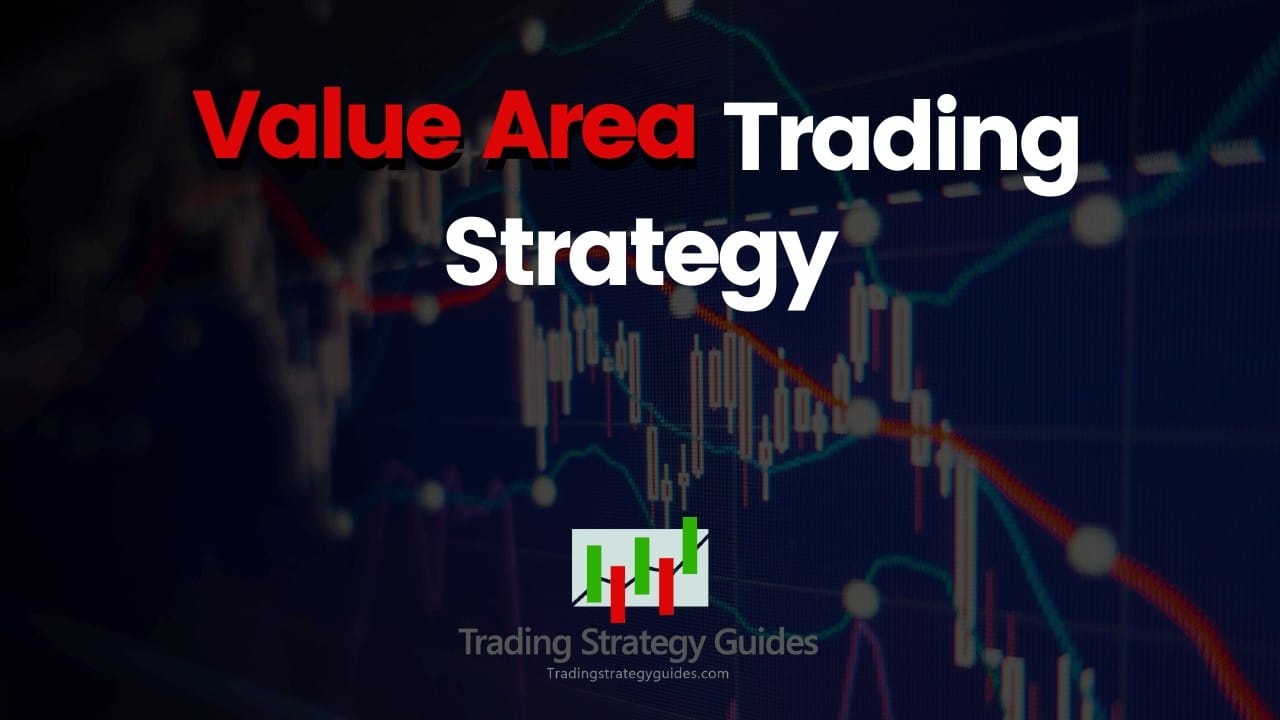
Learn the Value Area trading strategy if you want to master how institutional traders find support and resistance levels. You can use the Value Area trading rules to day trade any market and increase your profitability. In this guide, we’re going to teach you how to use the value areas as well as how to identify where the real big institutional traders are buying and selling.
If this is your first time on our website, our team at Trading Strategy Guides welcomes you. Make sure you hit the subscribe button, so you get your Free Trading Strategy every week directly into your email box.
If you feel you need a refresher or some prerequisite content, then you may want to check out the following articles:
Thanks for you patience! Now let’s learn the Value Area Trading Strategy.
Table of Contents
Introduction: Value Area Trading Strategy
One of the most important things you should track in trading after the price is VOLUME.
So, why is volume so important?
Let’s start with the basic: volume represents the amount of buying and selling that goes on. At the end of the day, the price of any asset class (forex currencies, stocks, futures, options, cryptocurrencies, etc.) is a supply and demand trading.
However, not all the volume is important, because only institutional buying and selling pressure can move the price of a stock. And, here is where the Volume Profile strategy also known as the Market Profile indicator comes to rescue us.
More specifically, we’re interested in using the Value Area in Volume Profile.
Let’s start with the Volume Profile Value Area definition and continue with how Value Area trading works.
What is the Value Area Trading?
In volume profile analysis, the value area measures where the most buying and selling volume took place.
More, the volume profile theory says that 70% of all asset prices will cluster around the value area.
Why 70%?
Because 70% is a rough approximation of one standard deviation on either side of the mean.
In other words, the value area levels highlight where 70% of the entire volume occurred during a particular trading session.
For example, if one profile individual bar displays a volume of 10, it means that 7 out of 10 shares that traded on a stock occurred within the value area levels. Value area is the price range where 70% of the trading volume occurred.
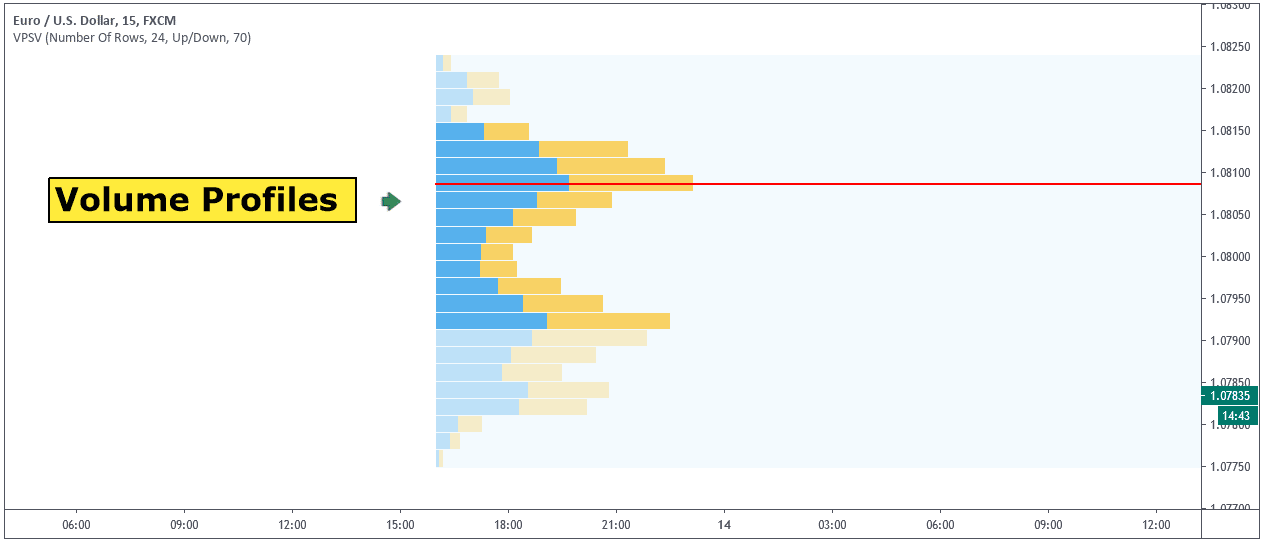
The Volume Profile value is constructed of 3 parts:
- Value Area High VAH.
- Value Area Low VAL.
- Point of Control VPOC.
The Point of Control Trading Strategy (POC) shows the single price level at which the most amount of volume was traded. While the value area low shows the lowest price level within the value area and the value area high shows the highest price level within the value area.
See the Volume Profile chart below:
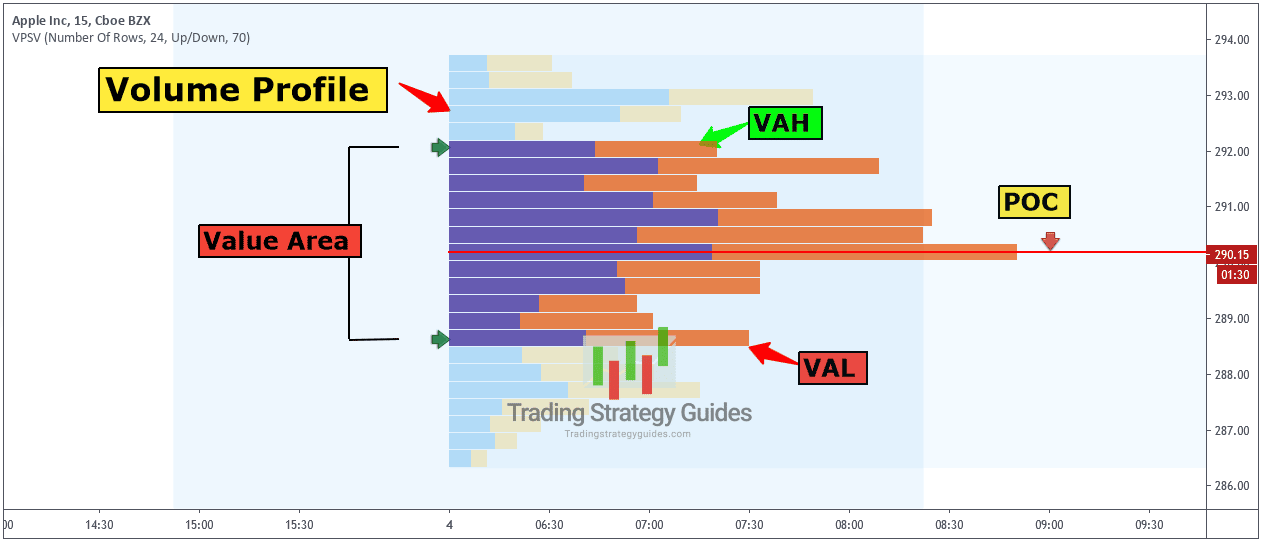
Note* The Value Area Volume is by default set at 70%.
Moving forward, let’s see the value area calculation process.
This will give you a better understanding of how valuable the value area levels can be.
How to Calculate Value Area:
Even though you get the value area levels served on a silver platter, it’s still important to know how the volume profile blocks are calculated.
Without further ado, these are the step-by-step value area calculation:
- Take the total buy and sell volume within a trading day and multiply it by 0.7 to determine 70% of the total volume.
- Record the greatest volume block aka the point of control (POC).
- Add the total volume of the first two blocks above the POC.
- Add the total volume of the first two blocks below the POC.
- Add to the POC the total volume, which is the greatest between the two volumes found at points 3 and 4.
- Repeat steps 3 and 4 adding the larger of the two numbers to the Value Area.
- Repeat the process until your Value Area slightly surpasses the number found in Step 1.
- The highest row within the Value Area represents the Value Area High (VAH) while the lowest row within the Value Area represents the Value Area Low (VAL).
Depending on the trading platform and stockbroker used, professional traders will have to pay anywhere between $50 and $500 to get access to the online volume profile.
So, if you don’t have money to spare for such things right now, you can always calculate them by hand.
Let’s see how to use a volume profile with TradingView and see how to put a volume profile on TradingView.
How to Apply Volume Profiles on TradingView
Important note: To apply the Volume Profiles on TradingView, you need to have a Pro level subscription or higher.
The Volume Profiles tool is such a valuable indicator that most professional trading platforms will charge you a fee to use it.
First and foremost, we’re starting with an intraday chart aka the 15-minute time frame.
See the stock chart below:

Note* The volume profiles work on any intraday time frame.
To apply volume profiles on your TradingView charts, go to the Volume Profile tab and select “Session Volume.”
The Volume Profiles will be plotted individually for each session. When the market closes and then reopens you have a new volume profile.
The volume will be placed on a horizontal scale rather than at the bottom of your charts where the standard volume indicator is displayed.

The Volume Profile is superior to the standard volume.
The horizontal volume is based on price and it’s not based on time. The time-based volume charts are only good to tell you the movement of the trend. On the other hand, the Volume Profiles tell you where there are institutional buying and selling or where there are large blocks of money traded and at what price.
This is very helpful in drawing institutional support and resistance levels.
Now, to make the value area levels more visible, go to the Volume Profile settings and under the “Style” tab change the color for:
- Value Area up.
- Value Area down.

Note* The Value Area up and Value Area down will show you the buying and selling in the 70% area. So, everything that is purple and orange highlights where 70% of the entire volume occurred.
Here are the top 3 things, why you should use Value Area trading:
- Plots on a vertical scale – give you a specific price level where the most volume has occurred.
- You gain a lot more information.
- Spot institutional support and resistance levels.
While trading the value area can be extremely profitable executing a trade is another story.
So, here are some value area trading rules you need to know so you turn the odds in your favor.
What are the Value Area Trading Rules?
Here is the reason why you want to know why 70% of the volume is occurring at a certain price level:
Large traders and institutional traders will be executing heavy volume. Wherever you see institutional trading activity, we‘re going to see an accumulation of large orders because they tend to be bigger traders.
This is a kind of self-fulfilling prophecy because where there’s a large volume, there’s going to be big support and resistance levels.
Wherever you see a thin volume, you’ll notice that the price moves through it very quickly.
Here is the lesson to learn about thin volume:
The small volume areas indicate a lack of trading activity. What typically happens when the price moves from the value area levels and go into these thin volume areas the price will travel really quickly to the next value area.

Here are some other value area trading rules we use in our trading:
For example, if we’re short, we use thin volume areas for the stop loss techniques placement.
We want to get stopped out when the price goes from value area levels to thin volume levels because there is no volume and there is a big change for the price to move further against you since there is no resistance to stop the price from rallying.
We’re going to teach you some secrets on how to improve trading using the value area and the 80% rule.
How to Use the 80% Rule:
What is the 80% rule?
The 80% rule asserts that if the stock price opens or move above/below the value area, but then returns to the value area twice for two half-hour periods, then we have an 80% probability of the value area to be filled.
For example, if the stock price action stays in the value area for 3 consecutive bars (assuming we’re using a 15-minute stock chart), and if the following bar opens inside the value area, the market has been for two half-periods (4 x 15-minute bars equal two half-periods) inside the value area.
This is the moment to watch for the 80% rule to get into play.
See the volume profile chart below:
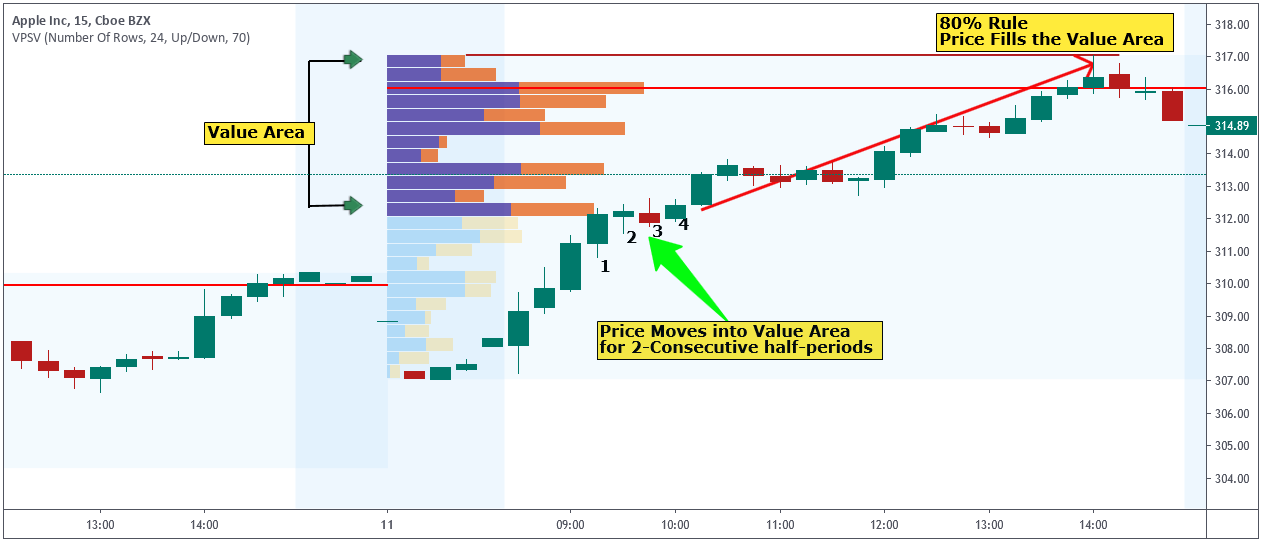
With this information alone, you can build a day trading strategy that has an 80% winning rate.
A good strategy you can build around the value area is to try to capture a fill-up of the value area.
We can build two different trading scenarios:
- If the stock price opens above the value area, but then falls in the value area for two consecutive half-periods, there is an 80% probability of the market filling the value area.
- If the stock price opens below the value area, but then rallies in the value area for two consecutive half-periods, there is an 80% probability of the market filling the value area.
Since the Value Area gives us valuable information about where the smart buying is interested to buy and sell, we can derive the best day trading strategies to take advantage of these findings.
See below:
Value Area Trading Strategy
We have built our value area trading strategy with the idea to take advantage of the fast intraday price movements. Check out our guide on successful intraday strategies.
For this, we’re going to use the Point of Control (POC) levels, which are like a magnet and they tend to pull the price near that POC levels.
The point of control simply shows the highest volume traded inside the value area.
The POC levels can act as good support and resistance levels:
- POC levels on the upside act as good resistance levels.
- POC levels on the downside act as good support levels.
Note* Right-click on the volume profile indicator, go to Settings – Inputs and click on the “Extend POC Right.” This will extend the POC levels from prior trading days to the right side of the screen.
So, here is our favorite value area trading setup:
Step Number #1
The current day point of control needs to align with yesterday’s point of control.
As a rule of thumb, we can only allow 2 volume blocks to separate the two POC.
The closer the POCs are, the better.
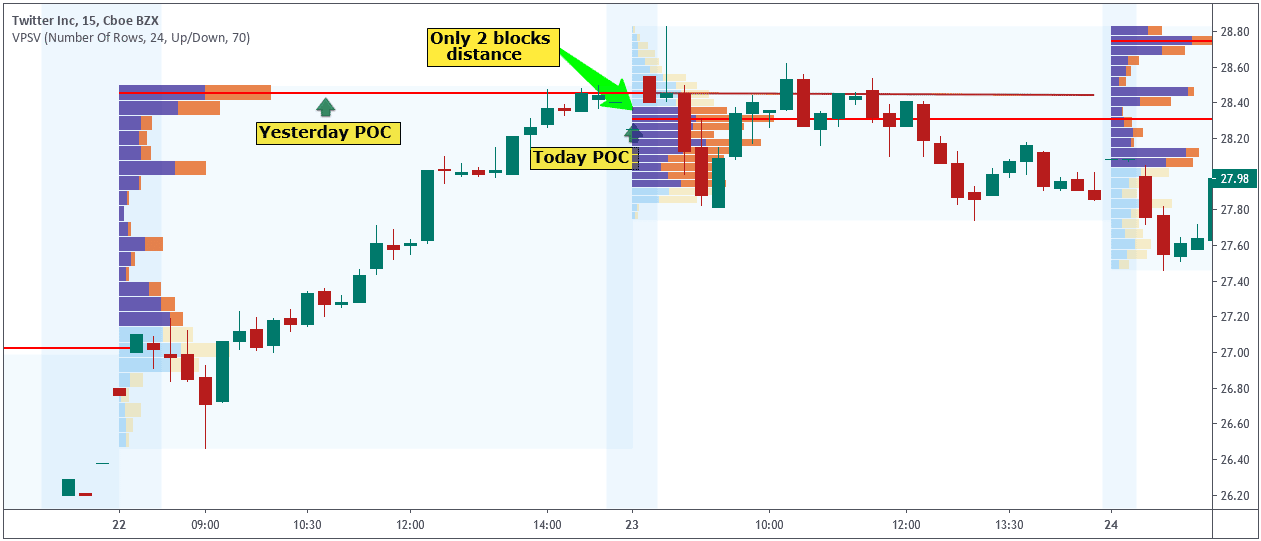
Once this condition is satisfied, it’s time to decide which direction to take the trade.
See below:
Step Number #2
If the stock is spending more time above the POC, then it’s a sign it will act as support and you want to buy. However, if the stock spends more time below the POC, it’s a sign it will act as resistance and you want to short that stock.
See the value area chart below:
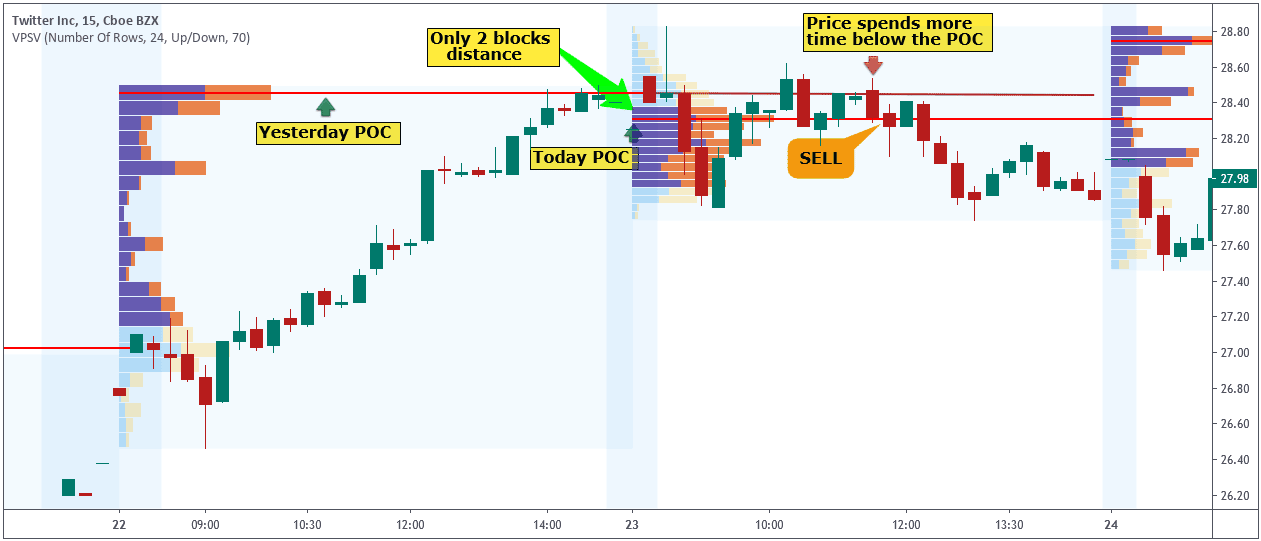
You can sell once we close below the current day’s POC (using the 15-minute chart).
Your protective stop loss can be placed above the current day high while you can exit the trade by the end of the day.
Now, since the value area is a versatile tool and can be used in many innovative ways, below we’re going to share with you more tips.
Value Area Trading Tips
We can gain a lot of useful information from the value area.
With that in mind, here are some valuable volume profiles trading tips:
- If the stock price opens above/below the value area and continues to stay above/below this indicative of institutional buying/selling. As a trader, you should expect the price to follow through.
- If the stock price opens above the value area and then it falls back inside the value area this is a strong bearish signal.
- If the stock price opens below the value area and then it rallies back inside the value area this is a strong bullish signal.
If you understand all the different ways the volume profile works, you can be better prepared to face any difficult situation that the markets may throw at you.
Final Words – Value Area Trading
In summary, if you want to escape the high degree of inherent randomness that comes with the price of any tradable instrument, you should look into value area trading. The Volume Profile is simply the footprint of smart money and you want to follow these footsteps because they can impact the price.
With the value area trading rules, you can gauge the market direction every single day. Once you start using the value area trading strategy and you get used to it, you’ll see day trading with different eyes.
Thank you for reading!
We also recommend learning about other trading strategies that have worked in 2023.
Feel free to leave any comments below, we do read them all and will respond.
Value Area Trading Strategy Video
Also, check out Tim Black teaching the Value Area Trading Strategy below!


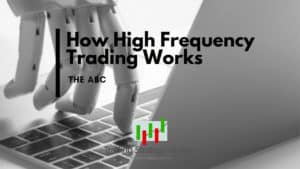




Highly informative. Thank you. Opened my eyes
Very much appreciated your Awesome explanation and thank you very much.
I started trading 2 months ago and I still trying to get a good balance on trading strategies this piece on value area trading has really helped me
thanks so much for this wonderful information and to hope learn from you more in my trading life this strategy alone is a gold mine
You kind soul, thank you for the valuable information, not all heroes wear capes
Great info and easy to grasp. How well does this strategy work on the 3 minute and 5 minute timeframes?